List of presidents of Bolivia
This President of the Plurinational State of Bolivia is the head of state and head of government of Bolivia, elected by popular vote to a 5-year (historically 4-year) term.[1]
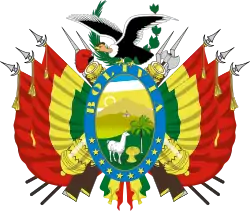 |
|---|
| This article is part of a series on the politics and government of Bolivia |
|
|
Since the office was established in 1825, 65 men and 2 women have served as president. Who the first president was is disputed among scholars.[2] While Simón Bolívar was proclaimed "liberator" on 11 August 1825, and the country named after him, he was never sworn-in having renounced the title in favor of Antonio José de Sucre. Sucre, on the other hand, was the interim holder of the office when Bolívar was chosen on 11 August and was president of the nation when its first Constitution was promulgated in 1826. The 65th president, Evo Morales, was the last president of the Republic of Bolivia and the first President of the Plurinational State of Bolivia. The third and current President of the Plurinational State is Luis Arce (since 8 November 2020). There are currently eight living former presidents. The most recent former president to die was Luis García Meza on 29 April 2018.
Pedro Blanco Soto held the shortest presidency being assassinated on 1 January 1829, just six days after assuming office on 26 December 1828, and fourteen days after being elected on 18 December. Evo Morales served the longest, over thirteen years, before resigning after the disputed 2019 general election. Morales is one of only five presidents to be successfully reelected and one of just two to be reelected consecutively. Ismael Montes, Gonzalo Sánchez de Lozada, Hernán Siles Zuazo, and Víctor Paz Estenssoro all achieved reelection for nonconsecutive terms while Paz Estenssoro had two consecutive terms. Víctor Paz Estenssoro and José Miguel de Velasco have the highest number of cumulative terms with four each, though Velasco was interim president for two of those and never completed a full term, while Morales has the highest number of consecutive terms with three.
Two presidents died in office (Germán Busch and René Barrientos), both are theorized to have been assassinted. Three presidents were confirmed to have been assassinated in office (Pedro Blanco Soto, Agustín Morales, and Gualberto Villaroel). Eighteen presidents resigned from office either willingly or under military pressure. Twenty-eight presidents were successfully ousted from office. Military triumvirates and juntas have held the presidency with no direct president on seven occasions in 1861, 1899, 1920-1921, 1970, 1978, 1981, and 1982 while multiple individuals ruled as singular presidents of a junta. For one month in 1928, Hernando Siles Reyes' cabinet ruled the country. René Barrientos and Alfredo Ovando Candía were the only co-presidents in Bolivian history while Simón Bolívar, Antonio José de Sucre and Andrés de Santa Cruz were the only presidents who were also heads of state of other countries. There have been six periods of time in 1839, 1841, 1848, 1879–1880, and most recently in 2019 in which there has been no head of state.
José Luis Tejada Sorzano was the first vice president to assume the presidency after the deposition of Daniel Salamanca Urey, though others, particularly presidents of either chambers of Congress, had done so in the past. Twelve presidents have held the presidency on an interim basis. Both women who have held the presidency (Jeanine Añez, and Lidia Gueiler Tejada) were interim presidents.
Antonio José de Sucre, at 30-years-old, was the youngest president while Victor Paz Estenssoro at the start of his fourth term in 1985 was the oldest president at age 78.[3] Lidia Gueiler Tejada was the first female president and Evo Morales was the first indigenous president.[lower-alpha 1]
Background
The origins of Bolivia are traceable to the Chuquisaca Revolution of 1809 in Upper Peru,[10] followed by the La Paz revolution within the same year, which was part of the Latin American wars of independence against Spanish colonial governments. Despite other struggles for independence, the insurgents immediately formed a constitutional government who rejected any oath or compromise with Spain. The rebel government also integrated all parts of population, including mestizos and indigenous. However, by the early 1810, the rebels were defeated, with their leaders executed or hunted down, leaving the neighboring countries of Peru and Argentina to fight for the controls of the Upper Peru areas.[11]
Presidents
Republic of Bolívar & Bolivia (1825–1836)
In early 1825, General Antonio José de Sucre led his army to Upper Peru after his triumph in the Battle of Ayacucho on 9 December 1824, which ended the Spanish rule over Peru, entering La Paz on 9 February 1825. After his arrival, he issued a decree considered the milestone of Bolivian independence, calling a "General Assembly of Deputies of Upper Peru" in the town of Oruro (then moved to Chuquisaca, present-day Sucre) to clarify the political status of the province.[12]
On 28 July 1825, representatives voted for three alternatives: unification with Lower Peru, annexation to the United Provinces of Rio de la Plata, or full independence and establishment of a republican state.[13] The large majority of deputies opted for independence, and the president of the Assembly José Mariano Serrano, together with a commission of three others, wrote the " Act of Independence ", which declared Upper Peru a country on 6 August 1825. The General Simón Bolívar was deeply popular in the region, and was immediately elected by the General Assembly as president. To honor who was considered one of the great libertadores, the delegates chose to name Upper Peru as "Republic of Bolívar", changing it into Bolivia on 3 October 1825, echoing the delegate Manuel Martín Cruz who stated "If to Romulus, Rome; to Bolívar, Bolivia" (Si de Rómulo, Roma; de Bolívar, Bolivia).[14]
| Presidency[lower-alpha 2] | President | Party | Designation | Government[lower-alpha 3] | Vice President | |||
|---|---|---|---|---|---|---|---|---|
| 1[lower-alpha 4] | 6 August 1825 – 11 August 1825 End of mandate |
 |
José Mariano Serrano |
Independent | Assumed command upon declaration of independence of the Republic of Bolívar (President of the Constituent Assembly) |
Interim[17][18] | Office blank to 19 Nov. 1826 | |
| 11 August 1825 – 12 August 1825 End of mandate |
 |
Antonio José de Sucre |
Independent | Assumed command while
waiting for Simón Bolívar |
Interim | |||
| 6 August 1825 – 12 August 1825 Assumed office – 29 December 1825 Renounced position |
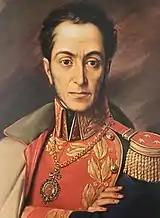 |
Simón Bolívar | Independent | Proclaimed by the Constituent Assembly (President of Gran Colombia, President of Peru) |
Legal | |||
| 2 | 29 December 1825 – 18 April 1828 Resigned from office – 2 August 1828 Official resignation |
 |
Antonio José de Sucre |
Independent | Appointed by Simón Bolívar[19] | Legal[20] (29 December 1825) | ||
| Elected by the Constituent Assembly | Legal provisional[21] (26 May 1826) | |||||||
| Constitutional
for life |
Vacant after 19 Nov. 1826 | |||||||
| 3 | 18 April 1828 – 2 August 1828 End of mandate |
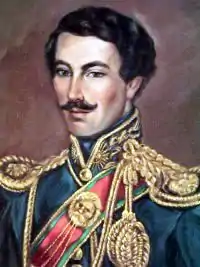 |
José María Pérez de Urdininea |
Independent | Appointed by Antonio José de Sucre (President of the Council of Ministers) |
Interim[lower-alpha 5] | Vacant throughout presidency | |
| From 2 to 12 August 1828, the presidency was fulfilled by President of the Council of Ministers José Miguel de Velasco. | ||||||||
| 4 | 12 August 1828 – 18 December 1828 End of mandate |
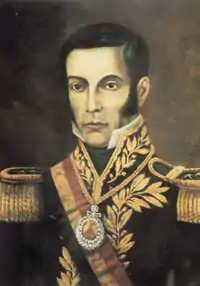 |
José Miguel de Velasco |
Independent | Succeeded to office according to Constitutional laws (Vice President of Andrés de Santa Cruz)[lower-alpha 6] |
Interim[25] | Same | |
| From 18 to 26 December 1828, the presidency was fulfilled by Vice President José Ramón de Loayza.[26] | ||||||||
| 5 | 18 December 1828 – 26 December 1828 Assumed office |
 |
Pedro Blanco Soto |
Independent | Elected by the Constituent Assembly | Provisional | José Ramón de Loayza | |
| From 1 to 31 January 1829, the presidency was fulfilled by José Miguel de Velasco. | ||||||||
| 6 | 31 January 1829 – 24 May 1829 End of mandate |
 |
José Miguel de Velasco |
Independent | Elected by the Constituent Assembly (Vice President of Andrés de Santa Cruz) |
Acting[27] | Same | |
| 31 January 1829 – 24 May 1829 Assumed office – 28 October 1836 Legal change |
 |
Andrés de Santa Cruz |
Independent | Elected by the Constituent Assembly | Provisional (31 January 1829) |
José Miguel de Velasco] | ||
| Reelected by the Constituent Congress | Constitutional[28] (14 August 1831) |
Mariano Enrique Calvo | ||||||
Bolivian State (1836–1839)
The Bolivian State was one of the three states that made up the Peru-Bolivian Confederation. On 28 October 1836, Andrés de Santa Cruz was elected Supreme Protector of the Peru-Bolivian Confederation by the Tapacarí, Huaura and Sicuani Congresses while simultaneously being the President of the Bolivian State. While Santa Cruz was the only official President of the Bolivian State, his vice president, Mariano Enrique Calvo, would be acting president in replacement of Santa Cruz when he was in Peruvian territory. As president, Santa Cruz was more concerned with military than administrative matters, as the country found itself in the War of the Confederation against Chile, and the war against the Argentine Confederation.
| Presidency | President | Party | Designation | Government | Vice President | |||
|---|---|---|---|---|---|---|---|---|
| 1 | 28 October 1836 – 20 February 1839 Resigned from office and fled to Ecuador |
 |
Andrés de Santa Cruz |
Independent | Elected by the Congress of Tapacarí | Constitutional[29] | Mariano Enrique Calvo | |
| 1836 – 20 February 1839 Resigned from office |
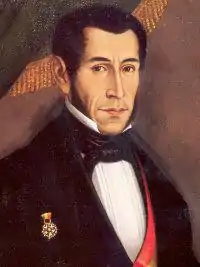 |
Mariano Enrique Calvo |
Independent | Appointed by Andrés de Santa Cruz (Vice President of Andrés de Santa Cruz) |
Acting[lower-alpha 7] | Same | ||
Republic of Bolivia (1839–2009)
Taking advantage of the internal anarchy caused by the dissolution of the Peru-Bolivian Confederation, on 22 February 1839, Jose Miguel de Velasco overthrew Marshal Andrés de Santa Cruz, thus assuming the presidency of the Bolivian State, which he ended with his secessionist pronouncement. Velasco promulgated the Political Constitution of 1839, repealing the Political Constitution of 1834, and giving rise to a new Republic of Bolivia.[30] The Republic of Bolivia was maintained for 170 years through multiple periods of military dictatorship and democracy and over a dozen constitutions.
| Presidency[lower-alpha 2] | President | Party | Designation | Government[lower-alpha 3] | Vice President | |||
|---|---|---|---|---|---|---|---|---|
| No government from 20 to 22 February 1839. José Ballivián proclaims himself president, but is unsuccessful. | ||||||||
| – | 22 February 1839 – 10 June 1841 Deposed by a coup d'état |
 |
José Miguel de Velasco |
Military | Installed by a coup d'état | De facto
(22 February 1839) |
Vacant to 26 Oct. 1839 | |
| Elected by the Constituent Congress | Provisional[32] (16 June 1839) | |||||||
| Elected by indirect vote | Constitutional[33]
(15 August 1840) |
Office blank 26 Oct. 1839[34] - 15 Feb. 1878[35] | ||||||
| 7 | 10 June 1841 – 9 July 1841 Resigned from office |
 |
Sebastián Ágreda | Military | Installed by a coup d'état | De facto[36] | ||
| 8 | 9 July 1841 – 22 September 1841 Deposed by a coup d'état |
 |
Mariano Enrique Calvo |
Independent | Appointed by Sebastián Ágreda | De facto | ||
| No government from 22 to 27 September 1841. | ||||||||
| 9 | 27 September 1841 – 23 December 1847 Resigned from office and fled to Chile |
.jpg.webp) |
José Ballivián | Military | Installed by a coup d'état | De facto
(27 September 1841) | ||
| Elected by the National Convention | Provisional[37] (23 April 1843) | |||||||
| General Election of 1844 | Constitutional[38] (15 August 1844) | |||||||
| 10 | 23 December 1847 – 2 January 1848 Deposed by a coup d'état |
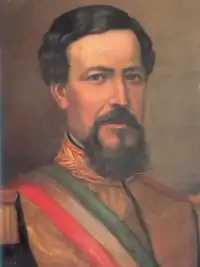 |
Eusebio Guilarte | Independent | Succeeded to office according
to Constitutional laws |
Constitutional | ||
| No government from 2 to 18 January 1848. | ||||||||
| – | 18 January 1848 – 6 December 1848 Deposed by a coup d'état |
 |
José Miguel de Velasco |
Military | Installed by a coup d'état | De facto[39] | ||
| 11 | 6 December 1848 – 15 August 1855 Resigned from office |
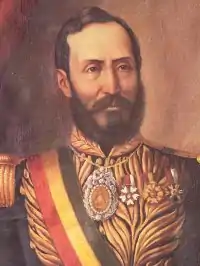 |
Manuel Isidoro Belzu |
Military | Installed by a coup d'état | De facto
(6 December 1848) | ||
| Elected by the Constituent Congress | De facto Provisional[40] (6 August 1850) | |||||||
| General Election of 1850 | Constitutional[41]
(15 August 1850) | |||||||
| Declared dictator[lower-alpha 8] | De facto[43]
(16 October 1850) | |||||||
| Elected by the National Convention | Constitutional[44]
(16 July 1851) | |||||||
| 12 | 15 August 1855 – 9 September 1857 Declared deposed by Linaristas[lower-alpha 9] – 27 September 1857 Defeated by insurgents and fled |
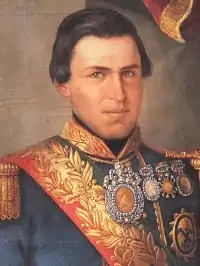 |
Jorge Córdova | Independent | General Election of 1855 | Constitutional | ||
| 13 | 9 September 1857 – 14 January 1861 Deposed by a coup d'état |
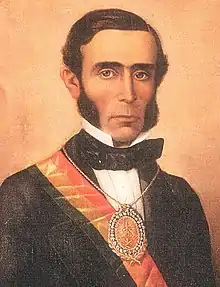 |
José María Linares |
Independent | Installed by a coup d'état | De facto | ||
| From 14 January to 4 May 1861, the presidency was fulfilled by a military triumvirate headed by José María de Achá, Ruperto Fernández, and Manuel Antonio Sánchez. | ||||||||
| 14 | 4 May 1861 – 28 December 1864 Deposed by a coup d'état |
 |
José María de Achá |
Military | Elected by National | Provisional[45]
(14 January 1861) | ||
| General Election of 1862 | Constitutional[46] | |||||||
| 15 | 28 December 1864 – 15 January 1871 Deposed by a coup d'état |
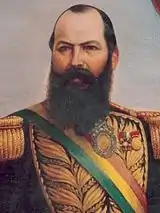 |
Mariano Melgarejo | Military | Installed by a coup d'état | De facto
(28 December 1864) | ||
| General Election of 1868 | Provisional[47] (15 August 1868) | |||||||
| Declared dictator | De facto[48]
(3 February 1869) | |||||||
| Constitutional freedoms restored | Provisional[49]
(31 May 1869) | |||||||
| General Election of 1870 | Constitutional[50]
(15 August 1870) | |||||||
| 16 | 15 January 1871 – 27 November 1872 Assassinated in office |
 |
Agustín Morales | Military | Installed by a coup d'état | De facto
(15 January 1871) | ||
| Elected by National | Provisional[51] (18 June 1871) | |||||||
| General Election of 1872 | Constitutional[52]
(25 August 1872) | |||||||
| 17 | 28 November 1872 – 9 May 1873 End of term |
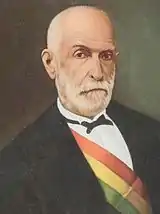 |
Tomás Frías Ametller |
Independent | Succeeded to office according
to Constitutional laws |
Constitutional | ||
| 18 | 9 May 1873 – 31 January 1874 Resigned from office[lower-alpha 10] |
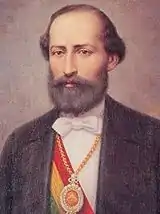 |
Adolfo Ballivián | Red | General Election of 1873 | Constitutional | ||
| From 31 January to 14 February 1874, the presidency was fulfilled by Tomás Frías Ametller. | ||||||||
| – | 14 February 1874 – 4 May 1876 Deposed by a coup d'état |
 |
Tomás Frías Ametller |
Independent | Succeeded to office according
to Constitutional laws |
Constitutional | ||
| 19 | 4 May 1876 – 17 April 1879 Ceded command – 28 December 1879 Declared deposed in his absence |
 |
Hilarión Daza | Military | Installed by a coup d'état | De facto (4 May 1876) | ||
| Elected by National Constituent Assembly |
Provisional[55] (15 November 1877) | |||||||
| Elected by National Constituent Assembly |
Constitutional[56] (15 February 1878) |
Vacant after 15 Feb. 1878 | ||||||
| From 17 April to 10 September 1879, the presidency was fulfilled by President of the Council of Ministers Pedro José Domingo de Guerra.[lower-alpha 11] | ||||||||
| From 10 September to 28 December 1879, the presidency was fulfilled by the Council of Ministers. | ||||||||
| No government from 28 December 1879 to 19 January 1880. | ||||||||
| 20 | 19 January 1880 – 4 September 1884 End of term |
 |
Narciso Campero | Independent[lower-alpha 12] | Proclaimed by a junta | Civil provisional
(19 January 1880) |
Vacant to 31 May 1880 | |
| Elected by the National Convention | Constitutional[59] (31 May 1880) |
Aniceto Arce[lower-alpha 13] (1st) | ||||||
| Belisario Salinas
(2nd) | ||||||||
| 21 | 4 September 1884 – 15 August 1888 End of term |
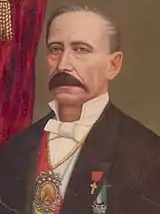 |
Gregorio Pacheco | Democratic[60] | General Election of 1884 | Constitutional | Mariano Baptista
(1st) | |
| Conservative[lower-alpha 14] | Jorge Oblitas
(2nd) | |||||||
| 22 | 15 August 1888 – 11 August 1892 End of term |
 |
Aniceto Arce | Conservative | General Election of 1888 | Constitutional | José Manuel del Carpio (1st) | |
| Serapio Reyes Ortiz (2nd) | ||||||||
| 23 | 11 August 1892 – 19 August 1896 End of term |
 |
Mariano Baptista | Conservative | General Election of 1892 | Constitutional[62] | Severo Fernández (1st) | |
| Vacant throughout presidency[lower-alpha 15] (2nd) | ||||||||
| 24 | 19 August 1896 – 12 April 1899 Deposed by a coup d'état |
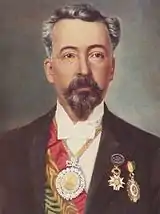 |
Severo Fernández | Conservative | General Election of 1896 | Constitutional[64] | Rafael Peña de Flores (1st) | |
| Jenaro Sanjinés
(2nd) | ||||||||
| From 12 April to 25 October 1899, the presidency was fulfilled by a civil-military triumvirate headed by José Manuel Pando, Serapio Reyes Ortiz, and Macario Pinilla Vargas. | ||||||||
| 25 | 25 October 1899 – 14 August 1904 End of term |
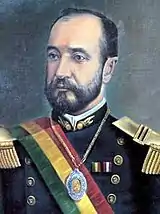 |
José Manuel Pando |
Liberal | Elected by the National Convention | Constitutional[65] | Lucio Pérez Velasco (1st) | |
| Aníbal Capriles Cabrera (2nd) | ||||||||
| 26 | 14 August 1904 – 12 August 1909 End of term[lower-alpha 16] |
 |
Ismael Montes | Liberal | General Election of 1904 | Constitutional[67] | Eliodoro Villazón
(1st) | |
| Valentín Abecia Ayllón (2nd) | ||||||||
| 27 | 12 August 1909 – 14 August 1913 End of term |
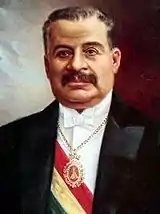 |
Eliodoro Villazón | Liberal | General Election of 1909 | Constitutional[68] | Macario Pinilla Vargas (1st) | |
| Juan Misael Saracho (2nd) | ||||||||
| – | 14 August 1913 – 15 August 1917 End of term |
 |
Ismael Montes | Liberal | General Election of 1913 | Constitutional[69] | Juan Misael Saracho (1st) | |
| José Carrasco Torrico (2nd) | ||||||||
| 28 | 15 August 1917 – 12 July 1920 Deposed by a coup d'état |
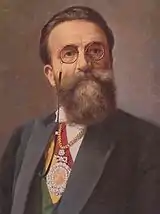 |
José Gutiérrez Guerra |
Liberal | General Election of 1917 | Constitutional[70] | Ismael Vázquez Virreira (1st) | |
| José Santos Quinteros (2nd) | ||||||||
| From 13 July 1920 to 28 January 1921, the presidency was fulfilled by a transitory triumvirate headed by Bautista Saavedra, José María Escalier, and José Manuel Ramírez. | ||||||||
| 29 | 28 January 1921 – 3 September 1925 Resigned from office |
 |
Bautista Saavedra | PRS | Elected by the National Convention | Constitutional[71] | Vacant throughout presidency | |
| 30 | 3 September 1925 – 10 January 1926 End of mandate |
 |
Felipe Segundo Guzmán |
PRS | Succeeded to office according
to Constitutional laws |
Interim[lower-alpha 17] | Vacant throughout presidency | |
| 31 | 10 January 1926 – 28 May 1930 Resigned from office |
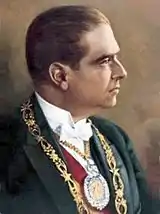 |
Hernando Siles Reyes |
PRS[lower-alpha 18] | General Election of 1925 | Constitutional | Abdón Saavedra | |
| PN | ||||||||
| From 28 May to 28 June 1930, the presidency was fulfilled by the presidential cabinet.[lower-alpha 19] | ||||||||
| 32 | 28 June 1930 – 5 March 1931 End of mandate |
 |
Carlos Blanco Galindo |
Military | Installed by a coup d'état
(President of the junta) |
De facto interim | Vacant throughout presidency | |
| 33 | 5 March 1931 – 27 November 1934 Resigned from office under military pressure – 1 December 1934 Official resignation[lower-alpha 20] |
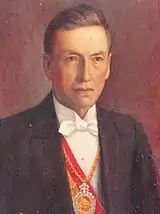 |
Daniel Salamanca Urey |
PRG | General Election of 1931 | Constitutional | José Luis Tejada Sorzano | |
| 34 | 1 December 1934 – 16 May 1936 Deposed by a coup d'état |
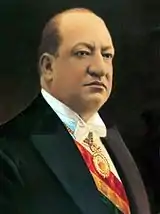 |
José Luis Tejada Sorzano |
Liberal | Installed by a coup d'état (Vice President of Daniel Salamanca) |
De facto[lower-alpha 21] | Vacant throughout presidency | |
| From 17 to 22 May 1936, the presidency was fulfilled by lieutenant colonel Germán Busch.[81] | ||||||||
| 35 | 22 May 1936 – 13 July 1937 Resigned from office under military pressure |
 |
David Toro | Military Socialist[lower-alpha 22] (Trend) |
Installed by a coup d'état
(President of the junta) |
De facto | Vacant throughout presidency | |
| 36 | 13 July 1937 – 23 August 1939 Died in office[lower-alpha 23] |
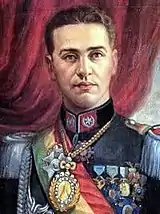 |
Germán Busch | Military Socialist
(Trend) |
Succeeded to lead the military junta
(President of the junta) |
De facto
(13 July 1937) |
Vacant to 28 May 1938 | |
| Elected by the National Convention | Constitutional[84]
(28 May 1938) |
Enrique Baldivieso | ||||||
| Declared dictator | De facto[85]
(24 April 1939) |
Vacant after 24 Apr. 1939 | ||||||
| 37 | 23 August 1939 – 15 April 1940 End of mandate |
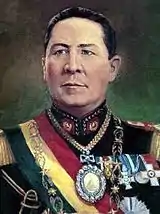 |
Carlos Quintanilla | Military | Appointed by the military | De facto interim[lower-alpha 24] | Vacant to 4 Dec. 1939 | |
| Office blank 4 Dec. 1939[86] - 24 Nov. 1945[87] | ||||||||
| 38 | 15 April 1940 – 20 December 1943 Deposed by a coup d'état |
 |
Enrique Peñaranda | Concordance[lower-alpha 25] | General Election of 1940 | Constitutional | ||
| 39 | 20 December 1943 – 21 July 1946 Assassinated in office |
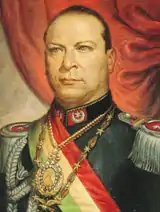 |
Gualberto Villarroel | RADEPA[lower-alpha 26] | Installed by a coup d'état
(President of the junta) |
De facto[89] (20 December 1943) | ||
| Receives command
from the junta |
De facto
provisional[90] (5 April 1944) | |||||||
| Elected by the National Convention | Constitutional[91]
(6 August 1944) |
Julián Montellano | ||||||
| 40 | 21 July 1946 – 17 August 1946 End of mandate |
 |
Néstor Guillén | Independent | Installed by a coup d'état
(President of the civil junta, President of the District Court of La Paz) |
De facto interim[lower-alpha 27] | Vacant throughout presidency | |
| 41 | 17 August 1946 – 10 March 1947 End of mandate |
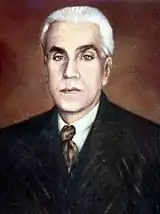 |
Tomás Monje | Independent | Receives command
from Néstor Guillén (President of the civil junta, President of the Supreme Court of Justice) |
De facto interim | Vacant throughout presidency | |
| 42 | 10 March 1947 – 22 October 1949 Resigned from office[lower-alpha 28] |
.jpg.webp) |
Enrique Hertzog | PURS | General Election of 1947 | Constitutional | Mamerto Urriolagoitía | |
| 43 | 24 October 1949 – 16 May 1951 Resigned from office[lower-alpha 29] |
.jpg.webp) |
Mamerto Urriolagoitía | PURS | Succeeded to office according to Constitutional laws (Vice President of Enrique Hertzog) |
Constitutional | Vacant throughout presidency | |
| 44 | 16 May 1951 – 11 April 1952 Deposed by a coup d'état |
.jpg.webp) |
Hugo Ballivián | Military | Receives command
from Mamerto Urriolagoitía |
De facto[94] | Vacant throughout presidency | |
| From 11 to 15 April 1952, the presidency was fulfilled by Vice President Hernán Siles Zuazo.[lower-alpha 30] | ||||||||
| 45 | 15 April 1952 – 6 August 1956 End of term |
.jpg.webp) |
Víctor Paz Estenssoro |
MNR | Receives command
from Hernán Siles Zuazo |
De facto | Hernán Siles Zuazo | |
| 46 | 6 August 1956 – 6 August 1960 End of term |
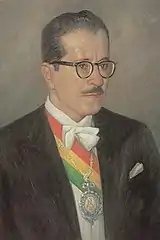 |
Hernán Siles Zuazo |
MNR | General Election of 1956 | Constitutional | Ñuflo Chávez Ortiz | |
| – | 6 August 1960 – 4 November 1964 Deposed by a coup d'état |
.jpg.webp) |
Víctor Paz Estenssoro |
MNR | General Election of 1960 | Constitutional | Juan Lechín Oquendo | |
| General Election of 1964 | René Barrientos | |||||||
| For less than a day on 5 November 1964, the presidency was fulfilled by a military junta headed by Alfredo Ovando Candía and René Barrientos.[lower-alpha 31] | ||||||||
| 47 | 5 November 1964 – 26 May 1965 Legal change |
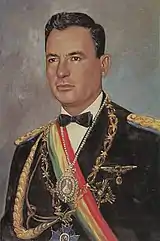 |
René Barrientos | Military | Installed by a coup d'état
(President of the junta) |
De facto[97] | Vacant throughout presidency | |
| 26 May 1965 – 2 January 1966 René Barrientos resigns from office[lower-alpha 32] |
Co-presidency[lower-alpha 33] | |||||||
| 48 | 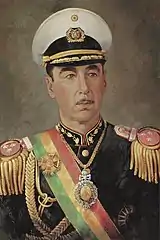 |
Alfredo Ovando Candía |
Military | De facto | Vacant throughout presidency | |||
| 2 January 1966 – 6 August 1966 End of term |
Receives full command
from René Barrientos | |||||||
| – | 6 August 1966 – 27 April 1969 Died in office[lower-alpha 34] |
 |
René Barrientos | MPC | General Election of 1966 | Constitutional[100] | Luis Adolfo Siles Salinas | |
| 49 | 27 April 1969 – 26 September 1969 Deposed by a coup d'état |
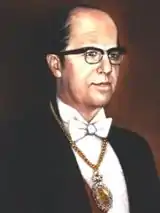 |
Luis Adolfo Siles Salinas |
PSD | Succeeded to office according
to Constitutional laws |
Constitutional[101] | Vacant throughout presidency | |
| – | 26 September 1969 – 6 October 1970 Deposed by a coup d'état |
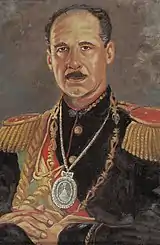 |
Alfredo Ovando Candía |
Military | Installed by a coup d'état | De facto[102] | Vacant throughout presidency | |
| For one day on 6 October 1970, the presidency was fulfilled by a military triumvirate headed by Efraín Guachalla, Fernando Sattori, and Alberto Albarracín.[lower-alpha 35] | ||||||||
| 50 | 7 October 1970 – 21 August 1971 Deposed by a coup d'état |
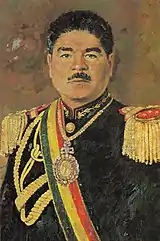 |
Juan José Torres |
Military | Installed by a coup d'état | De facto | Vacant throughout presidency | |
| 51 | 21 August 1971 – 21 July 1978 Resigned from office under military pressure |
.jpg.webp) |
Hugo Banzer | Military | Installed by a coup d'état | De facto[104] | Vacant throughout presidency | |
| For less than a day on 21 July 1978, the presidency was fulfilled by a military triumvirate headed by Víctor González Fuentes, Alfonso Villalpando, and Gutemberg Barroso.[lower-alpha 36] | ||||||||
| 52 | 21 July 1978 – 24 November 1978 Deposed by a coup d'état |
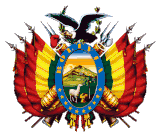 |
Juan Pereda | Military | Installed by a coup d'état | De facto | Vacant throughout presidency | |
| 53 | 24 November 1978 – 8 August 1979 Ceded command |
 |
David Padilla | Military | Installed by a coup d'état | De facto[106] | Vacant throughout presidency | |
| 54 | 8 August 1979 – 1 November 1979 Deposed by a coup d'état |
 |
Wálter Guevara | PRA | Elected by the National Congress (President of the National Senate) |
Interim[lower-alpha 37] | Vacant throughout presidency | |
| 55 | 1 November 1979 – 16 November 1979 Resigned from office under government pressure |
 |
Alberto Natusch | Military | Installed by a coup d'état | De facto[108] | Vacant throughout presidency | |
| 56 | 16 November 1979 – 17 July 1980 Deposed by a coup d'état |
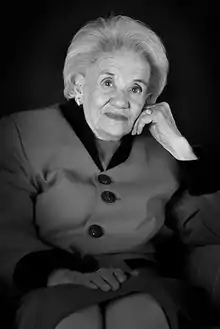 |
Lidia Gueiler Tejada |
PRIN | Elected by the National Congress (President of the Chamber of Deputies) |
Interim[lower-alpha 38] | Vacant throughout presidency | |
| 57 | 17 July 1980 – 4 August 1981 Resigned from office under military pressure |
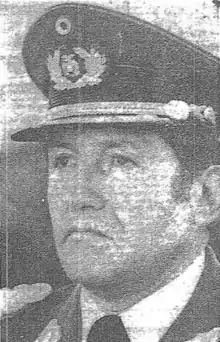 |
Luis García Meza |
Military | Installed by a coup d'état
(President of the junta) |
De facto | Vacant throughout presidency | |
| From 4 August to 4 September 1981, the presidency was fulfilled by a military triumvirate headed by Celso Torrelio, Waldo Bernal Pereira, and Óscar Pammo Rodríguez.[109] | ||||||||
| 58 | 4 September 1981 – 19 July 1982 Ceded command |
 |
Celso Torrelio | Military | Receives command
from the junta |
De facto[110] | Vacant throughout presidency | |
| From 19 to 21 July 1982, the presidency was fulfilled by a military triumvirate headed by Ángel Mariscal, Natalio Morales, and Óscar Pammo Rodríguez.[lower-alpha 39] | ||||||||
| 59 | 21 July 1982 – 10 October 1982 Ceded command |
 |
Guido Vildoso | Military | Receives command
from the junta |
De facto[112] | Vacant throughout presidency | |
| – | 10 October 1982 – 6 August 1985 End of term |
 |
Hernán Siles Zuazo |
MNRI | General Election of 1980[lower-alpha 40] | Constitutional | Jaime Paz Zamora | |
| Vacant after 14 Dec. 1984 | ||||||||
| – | 6 August 1985 – 6 August 1989 End of term |
.jpg.webp) |
Víctor Paz Estenssoro |
MNR | General Election of 1985 | Constitutional[114] | Julio Garrett Ayllón | |
| 60 | 6 August 1989 – 6 August 1993 End of term |
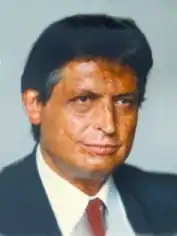 |
Jaime Paz Zamora |
MIR | General Election of 1989 | Constitutional[115] | Luis Ossio | |
| 61 | 6 August 1993 – 6 August 1997 End of term |
 |
Gonzalo Sánchez de Lozada |
MNR | General Election of 1993 | Constitutional[116] | Víctor Hugo Cárdenas | |
| – | 6 August 1997 – 7 August 2001 Resigned from office |
 |
Hugo Banzer | ADN | General Election of 1997 | Constitutional[117] | Jorge Quiroga | |
| 62 | 7 August 2001 – 6 August 2002 End of term |
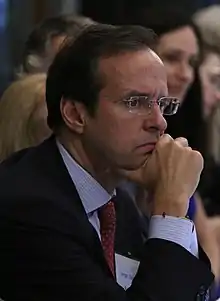 |
Jorge Quiroga | ADN | Succeeded to office according
to Constitutional laws |
Constitutional[118] | Vacant throughout presidency | |
| – | 6 August 2002 – 17 October 2003 Resigned from office |
 |
Gonzalo Sánchez de Lozada |
MNR | General Election of 2002 | Constitutional | Carlos Mesa | |
| 63 | 17 October 2003 – 9 June 2005 Resigned from office |
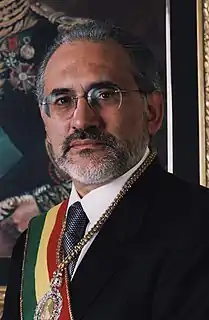 |
Carlos Mesa | Independent | Succeeded to office according
to Constitutional laws |
Constitutional[119] | Vacant throughout presidency | |
| 64 | 9 June 2005 – 22 January 2006 End of mandate |
 |
Eduardo Rodríguez Veltzé |
Independent | Succeeded to office according
to Constitutional laws |
Interim[120] | Vacant throughout presidency | |
| 65 | 22 January 2006 – 22 January 2010 Legal change |
_(cropped).jpg.webp) |
Evo Morales | MAS-IPSP | General Election of 2005 | Constitutional[121] | Álvaro García Linera | |
Plurinational State of Bolivia (2009–present)
The emergence of the Plurinational State occurred as a consequence of the promulgation of the Political Constitution of 2009. Drafted by the Constituent Assembly in 2007, the new constitution was approved in a popular referendum on 25 January 2009, and was promulgated on 7 February. The Constitution resulted in a change in the official name of the country, leaving behind its previous denominative of Republic of Bolivia to become the Plurinational State of Bolivia. In order to comply with the structural changes of the new constitution, it was decided to advance the general elections to be held on 6 December 2009, with Evo Morales winning again, with 64.22% of the votes. This situation made Evo Morales Ayma the last president of the Republic and the first of the Plurinational State.
| Presidency[lower-alpha 2] | President | Party | Designation | Government[lower-alpha 3] | Vice President | |||
|---|---|---|---|---|---|---|---|---|
| 65 | 22 January 2010 – 10 November 2019 Resigned from office under military pressure |
_(cropped).jpg.webp) |
Evo Morales | MAS-IPSP | General Election of 2009 | Constitutional | Álvaro García Linera | |
| General Election of 2014 | ||||||||
| Office vacant 10–12 November 2019.[lower-alpha 41] | ||||||||
| 66 | 12 November 2019 – 8 November 2020 End of mandate |
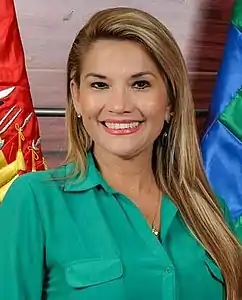 |
Jeanine Áñez | MDS | Succeeded to office according
to Constitutional laws of the Senate) |
Interim[125][126] | Vacant throughout presidency | |
| 67 | 8 November 2020 – Incumbent |
_(cropped).jpg.webp) |
Luis Arce | MAS-IPSP | General Election of 2020 | Constitutional | David Choquehuanca | |
Timeline

Living former presidents
As of 10 February 2021, there are eight living former presidents:

Guido Vildoso
(1982)
5 April 1937
Jaime Paz Zamora
(1989–1993)
15 April 1939
Jorge Quiroga
(2001–2002)
5 May 1960
Gonzalo Sánchez de Lozada
(2002–2003)
11 July 1930
Carlos Mesa
(2003–2005)
12 August 1953
Eduardo Rodríguez Veltzé
(2005–2006)
2 March 1956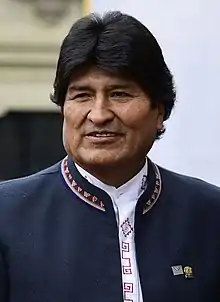
Evo Morales
(2006–2019)
26 October 1959
Jeanine Áñez
(2019–2020)
13 August 1967
The most recent death of a former president was that of Luis García Meza (1980–1981) on 29 April 2018; he was 88 years old.[127]
Notes
- Morales is described as the first indigenous president of Bolivia in academic studies of his presidency, such as those of Muñoz-Pogossian,[4] Webber,[5] Philip and Panizza,[6] and Farthing and Kohl,[7] as well as in press reports, such as those of BBC News. However, there have been challenges to this claim by critics who have asserted that Morales probably has some European ancestry, and thus on genetic grounds is technically mestizo rather than solely indigenous.[8] Further, former president Enrique Peñaranda was of substantially indigenous origin. Harten asserted that this argument was "misguided[,] wrong[... and] above all irrelevant" because regardless of his genetic makeup, the majority of Bolivians perceive Morales as being the first indigenous president.[8] In Bolivian society, indigeneity is a fluid concept rooted in cultural identity;[8] for instance, many indigenous individuals that have settled in urban areas and abandoned their traditional rural customs have come to identify as mestizo.[9]
- Presidents are numbered according to the first period of time served. For example, Tomás Frías served two nonconsecutive terms but is counted only as the seventeenth president (not the seventeenth and nineteenth). A vice president who temporarily becomes acting president is not counted, because the president remains in office during such a period. Military triumvirates in which multiple people lead are not counted but singular presidents of a junta are. René Barrientos and Alfredo Ovando were briefly co-presidents but are counted separately. Interim presidents are counted.
- In Bolivia, presidents are divided between two groups. The first are what are classified as "Constitucionales" having come to power legally or through quasi-legal means (achieving power through a revolution or coup d’état but later constitutionalised). The rest are either de facto having come to power militarily and never constitutionalised, or interim having been placed in power only until a new president is chosen. Interim presidents have been both constitutional and de facto.[15]
- The question of whether Simón Bolívar or Antonio José de Sucre should be considered the first president of Bolivia is a source of dispute.[16]
- The government of José María Pérez de Urdininea was not a succession but a temporary delegation of command, while Sucre was recovering from a gunshot wound to his arm, which occurred in the Mutiny of 18 April 1828.[22][23]
- On 12 August 1829, Congress elected Andrés de Santa Cruz as president and José Miguel de Velasco as vice president. As Santa Cruz was in Santiago, Velasco became interim president in his absence. However, Santa Cruz never appeared with Velasco remaining as interim president until the convening of a Conventional Assembly to elect new leaders[24]
- Andrés de Santa Cruz assumed the position of Supreme Protector of the Peru-Bolivian Confederation in parallel with that of the presidency of Bolivia. On 23 July 1835, Mariano Enrique Calvo is appointed vice president. In 1836, he assumes the acting presidency of Bolivia in Santa Cruz's absence, in order to act as the representative of the Bolivian State in the Confederation, while Santa Cruz was in Lima governing the Confederation.
- Dictatorial measures had already been adopted by 7 September.[42]
- On 9 September 1857, José María Linares was proclaimed president in Oruro rising militarily against the government of Jorge Córdova. Córdova and his forces were finally defeated by the Linaristas in Cochabamba on 27 September.
- Adolfo Ballivián resigned from office on account of his stomach cancer. Tomás Frías took the presidency on an interim basis. Ballivián died 2 weeks later on 14 February 1874, at which point Frías became Constitutional president.[53][54]
- On 17 April 1879, Hilarión Daza ceded command of the government to his Council of Ministers, chaired by Pedro José de Guerra, and took the lead of the Bolivian troops during the War of the Pacific. The Council of Ministers in charge of the Executive Power ended its mandate with the death of de Guerra in September of that year, leaving the Ministry of Government and Foreign Relations vacant, later occupied by Serapio Reyes Ortiz. It is not clear whether Reyes Ortiz presided over the new Council of Ministers. Hilarión Daza is generally regarded as the president who was overthrown in December 1879.
- Narciso Campero had no official affiliation with any party but held Liberal tendencies.[57]
- On 31 May 1880, Narciso Campero was appointed Constitutional president and Aniceto Arce and Belisario Salinas were appointed first and second vice presidents respectively. This began a period of dual-vice presidency which lasted until the presidency of José Gutiérrez Guerra after which the practice came to an end.
- Though elected as part of the Democratic party, Pacheco ruled in coalition with the Conservatives and supported the electoral campaign of Aniceto Arce in 1888.[61]
- The second vice presidency remains vacant due to the death of the elected citizen Juan Federico Zuazo before taking office.[63]
- In the general election of 4 May 1908, the Liberal Fernando Eloy Guachalla is elected president with Eufronio Viscarra and Fidel Valdez elected first and second vice president respectively. However, Guachalla would die of natural causes before assuming office. Though vice president-elect Eufronio Viscarra tried to claim the right to succession, Ismael Montes decided to extend his mandate for another year and annul the election.[66]
- In the general elections of 2 May 1925, the Republican José Gabino Villanueva was elected president and Abdón Saavedra elected vice president. However, both Villanueva and Saavedra would be denounced for not having resigned from their public positions 6 months before their application of candidacy. As a consequence, the general elections were annulled. President of the National Senate Felipe Segundo Guzmán assumed the presidency on an interim basis until new elections could be called.[72]
- In 1926, Hernando Siles Reyes split with the Saavedristas of the Socialist Republican Party (PRS) and formed the Nationalist Party (PN) on 29 December 1926.[73]
- On 28 May 1930, Hernando Siles Reyes resigned and left command of the country to his cabinet with the idea that it would immediately convene a constituent assembly that would amend the Constitution and reelect him. However, the cabinet could not weather the storm of popular discontent and was deposed by a coup d'état on 28 June at which point Carlos Blanco Galindo became interim president.[74]
- On 27 November 1934, as a result of disputes with his high command over the conduct of the Chaco War, Daniel Salamanca was forced to resign while visiting the front line. The army decided to keep up democratic appearances and instead of taking power directly, Vice President José Luis Tejada was allowed to succeed to the presidency.[75] Though Tejada assumed the office of president on 28 November 1934, his term officially started on 1 December when Salamanca's official resignation arrived.[76][77]
- In the general election of 11 November 1934, the Genuine Republican Franz Tamayo was elected president with Rafael de Ugarte elected vice president. Given the coup which occurred against Salamanca two weeks later, the results were annulled.[78] Though as vice president José Luis Tejada Sorzanoa could Constitutionally succeed Salamanca, the annulment of the 1934 results makes his presidency unconstitutional.[79] However, official records of the time names Tejada Sorzano Constitutional President of the Republic.[80]
- Though not an official party, Military Socialism is an expression used in Bolivia to refer to the military governments of Toro and Busch. It was a coalition between the army, labor movements, and left parties.[82]
- Though generally accepted today that Germán Busch committed suicide, there was and is still controversy over whether he was in fact assassinated by his brother-in-law on behalf of conservative elements of the military.[83]
- On 23 August 1939, Germán Busch committed suicide. Though Vice President Enrique Baldivieso tried to convince the military chiefs to allow him to assume the presidency, General Quintanilla was soon elevated to the position on the basis that since Busch had declared himself dictator four months prior, the constitutional order was thus null and void.
- Concordance was a coalition of the traditionalist Liberal (PL), Genuine Republican (PRG), and Socialist Republican (PRS) parties created in order to consolidate the vote for the 1940 general elections.[88]
- Razón de Patria, or Fatherland's Cause (RADEPA), while not a political party, was a military faction of young officers inspired by the Military Socialist governments of David Toro and Germán Busch.
- On 21 July 1946, Gualberto Villarroel was deposed and murdered by a mob in La Paz during a popular uprising. Upon the death of Villarroel, the alliance of forces that had toppled him settled on the President of the Supreme Court of Justice, Tomás Monje Gutiérrez, as interim president. Since Monje was ill at the time, the Attorney General of La Paz, Néstor Guillén, filled in for him as interim president for fewer than four weeks, whereupon Monje was sworn-in.
- In 1949, PURS leadership lost confidence in Hertzog and forced his resignation on 22 October in favor of his vice president, Mamerto Urriolagoitía, under the pretext of a non-existent disease. Urriolagoitía held executive power immediately after Hertzog's resignation but his term officially started two days later following his inauguration on 24 October.[92]
- In the general elections of 6 May 1951, the Revolutionary Nationalist Movement (MNR) party candidate Víctor Paz Estenssoro and Hernán Siles Zuazo won the majority. However, since neither the MNR nor PURS won an absolute majority of votes, the National Congress was constitutionally obliged to elect a president from the top three contenders. Faced with the possibility that Estenssoro might still win, Mamerto Urriolagoitía resigned in a self-coup in favor of the army which annulled the election results.[93]
- On 9 April 1952, the Bolivian National Revolution of 1952 saw the MNR, victors of the annulled 1951 general election, take power by force. On 11 April, Hugo Ballivián was ousted and Hernán Siles Zuazo, the 1951 vice presidential candidate, took the presidency in the absence of Víctor Paz Estenssoro who was in exile in Buenos Aires. On 15 April, Siles handed Paz Estenssoro the presidential sash, thus respecting the result of the 1951 presidential elections.[95]
- In late October 1964, Víctor Paz Estenssoro asked the army to quell a miner uprising. This, drove his own vice president, René Barrientos, and General Alfredo Ovando to launch a coup d'état on 4 November. However, Alfredo Ovando was prevented from taking power as president of the junta due to pressure of the masses who accused him of having allowed Paz Estenssoro to flee the country. For this reason, René Barrientos assumed the presidency instead.[96]
- On 2 January 1966, René Barrientos resigned as co-president in order to run in the 1966 general elections that coming July. Alfredo Ovando Candía became singular president from this point.
- Although both René Barrientos and Alfredo Ovando exercised leadership in the military junta, due to the events of 5 November, Barrientos held the singular presidency of the junta. However, faced with discontent from Ovando loyalists, Barrientos established the co-presidency between himself and Ovando on 26 May 1965. This is the only example of two presidents ruling at once in Bolivian history.[98]
- On 27 April 1969, René Barrientos died in a helicopter crash when his helicopter collided with telegraph wires. There is controversy whether his death was truly an accident or a plot by Alfredo Ovando Candía who would soon overthrow Barrientos' successor, Vice President Luis Adolfo Siles.[99]
- On 6 October 1970, Alfredo Ovando was deposed in a coup d'état led by the chiefs of the army, air force, and navy. The military triumvirate was quickly defeated by Ovando loyalists led by Juan José Torres. Ovando agreed not to return to the presidency, entrusting it with Torres.[103]
- Under pressure from the Carter administration, Hugo Banzer held the general elections of 9 July 1978. The Nationalist Union of the People (UNP) coalition candidate Juan Pereda won with a few thousand votes enough to win the presidency outright without requiring a run off. The election was blatantly rigged against leftist ex-president Hernán Siles Zuazo and the results were annulled and the electoral fraud blamed on Pereda who in turn staged a rebellion. Banzer was forced to resign in favor of a triumvirate of his military chiefs who themselves were deposed in a coup d'état which installed Juan Pereda as president on 21 July 1978.[105]
- In the general elections of 1 July 1979, neither the Democratic and Popular Union coalition candidate Hernán Siles Zuazo nor the Revolutionary Nationalist Movement–Alliance (MNR) coalition candidate Víctor Paz Estenssoro reached 40% of the vote. Since neither won an absolute majority of votes, the National Congress was constitutionally obliged to elect a president from the top three contenders but could not reach an agreement and instead elected the President of the Senate Wálter Guevara as interim president until new elections could be called.[107]
- On 1 November 1979, Wálter Guevara was deposed by Alberto Natusch. However, Natusch faced popular opposition from both the government and the people forcing him to resign after just 16 days. In order to save face, he extracted from Congress the condition that Guevara would not be allowed to resume the post of interim presidency and Lidia Gueiler Tejada, president of the lower chamber, was elected interim president instead.
- On 19 July 1982, the repressive government of Celso Torrelio is asked to resign in favor of a military junta which on 21 July appoints Guido Vildoso to take the office of the presidency until the country can transition to democracy.[111]
- On 10 October 1982, the military government of Guido Vildoso recognized the results of the annulled 1980 general elections and handed command to Hernán Siles Zuazo.[113]
- In the general election of 10 October 2019, Evo Morales won reelection but was accused of electoral fraud by the OAS. Following protests, Morales and top MAS leadership resigned and left La Paz to Chimoré, resulting in a political crisis in which Bolivia experienced a period of lack of government and misrule. Between 10 and 12 November it came to the Legislature in session to accept or reject the resignation of Morales and elect a new president, but given the absence of assemblymen of the Movement for Socialism, who demanded guarantees for meetings[123] the Plurinational Constitutional Court intervened and recognized the de facto proclamation of second vice president of the Senate, opposition senator Jeanine Áñez, as interim president by constitutional succession, through a Constitutional Sentence.[124]
References
- "South America :: Bolivia — The World Factbook - Central Intelligence Agency". www.cia.gov. Retrieved 27 October 2020.
- Mendoza, Luz. "¿Quién fue el primer presidente de Bolivia?; se enciende el debate por el cargo de Simón Bolívar". eju.tv (in Spanish). Retrieved 27 October 2020.
- "Presidentes de Bolivia, en números". Correo del Sur (in Spanish). Retrieved 30 October 2020.
- Muñoz-Pogossian 2008, p. 180.
- Webber 2011, p. 1.
- Philip & Panizza 2011, p. 57.
- Farthing & Kohl 2014, p. 1.
- Harten 2011, p. 7.
- Farthing & Kohl 2014, p. 22.
- Notimérica, ed. (5 May 2017). "La Revolución de Chuquisaca, 207 años del Primer Grito Libertario de América" (in Spanish).
- Biblioteca Virtual Miguel de Cervantes (ed.). "Doctrina del libertador/Simón Bolívar; prólogo Augusto Mijares; compilación, notas y cronología Manuel Pérez Vila" (in Spanish). Retrieved 2 August 2019.
- Urgentebo, ed. (9 August 2016). "La independencia de Bolivia y el Decreto de 9 de febrero de 1825" (in Spanish).
- Quispe, Jorge (6 August 2012). La Razón (ed.). "El 'país viable' que convenció a Bolívar" (in Spanish).
- Notimérica, ed. (4 September 2018). "¿Por qué Bolivia se llama Bolivia?" (in Spanish).
- "Inhalt". Jahrbuch für Geschichte Lateinamerikas – Anuario de Historia de America Latina. 53 (1): 7–8. 1 December 2016. doi:10.7767/jbla-2016-0101.
- Mendoza, Luz. "¿Quién fue el primer presidente de Bolivia?; se enciende el debate por el cargo de Simón Bolívar". eju.tv (in Spanish). Retrieved 21 October 2020.
- "El doctor José Mariano Serrano y la independencia americana". www.eldiario.net (in Spanish). Retrieved 21 October 2020.
- Alexander (6 August 2018). "UN ANALISIS PROFUNDO DEL ACTA DE INDEPENDENCIA DE LAS PROVINCIAS DEL ALTO PERU- HOY BOLIVIA". Alexander Telleria Gutiérrez (in Spanish). Retrieved 21 October 2020.
- "DECRETO SUPREMO del 29 de Diciembre de 1825 – 2 » Derechoteca.com". www.derechoteca.com. Retrieved 21 October 2020.
- "DECRETO SUPREMO del 29 de Diciembre de 1825 – 2 » Derechoteca.com". www.derechoteca.com. Retrieved 26 October 2020.
- "Bolivia: Ley de 26 de mayo de 1826". www.lexivox.org. Retrieved 26 October 2020.
- "El atentado del 18 de abril de 1828". www.eldiario.net (in Spanish). Retrieved 21 October 2020.
- "José María Pérez de Urdininea (1784-1865): Fue presidente de Bolivia". Retrieved 21 October 2020.
- "EL LABERINTO HISTÓRICO DE LAS SUCESIONES PRESIDENCIALES EN BOLIVIA | Historias de Bolivia". EL LABERINTO HISTÓRICO DE LAS SUCESIONES PRESIDENCIALES EN BOLIVIA | Historias de Bolivia. Retrieved 24 October 2020.
- "Bolivia: Ley de 12 de agosto de 1828". www.lexivox.org. Retrieved 21 October 2020.
- "Acerca del general José Ramón de Loayza". www.eldiario.net (in Spanish). Retrieved 21 October 2020.
- "DECRETO SUPREMO No 31-01-1829 del 31 de Enero de 1829 » Derechoteca.com". www.derechoteca.com. Retrieved 21 October 2020.
- "Bolivia: Constitución política de 1831, 14 de agosto de 1831". www.lexivox.org. Retrieved 22 October 2020.
- "Mariscal Andrés de Santa Cruz". www.eldiario.net (in Spanish). Retrieved 22 October 2020.
- "Bolivia: Constitución política de 1839, 26 de octubre de 1839". www.lexivox.org. Retrieved 26 October 2020.
- "Inhalt". Jahrbuch für Geschichte Lateinamerikas – Anuario de Historia de America Latina. 53 (1): 7–8. 1 December 2016. doi:10.7767/jbla-2016-0101.
- "Bolivia: Ley de 16 de junio de 1839". www.lexivox.org. Retrieved 22 October 2020.
- "Bolivia: Ley de 15 de agosto de 1840". www.lexivox.org. Retrieved 22 October 2020.
- "Bolivia: Constitución política de 1839, 26 de octubre de 1839". www.lexivox.org. Retrieved 15 November 2020.
- "Bolivia: Constitución política de 1878, 15 de febrero de 1878". www.lexivox.org. Retrieved 15 November 2020.
- "SEBASTIÁN ÁGREDA | Historias de Bolivia". SEBASTIÁN ÁGREDA | Historias de Bolivia. Retrieved 22 October 2020.
- "Accept Terms and Conditions on JSTOR". www.jstor.org. Retrieved 22 October 2020.
- "Google Translate". translate.google.com. Retrieved 23 October 2020.
- "RED ESCUELA.: Jose Miguel De Velasco". www.redescuela.org. Retrieved 22 October 2020.
- "Bolivia: Ley de 6 de agosto de 1850". www.lexivox.org. Retrieved 22 October 2020.
- "Bolivia: Ley de 14 de agosto de 1850". www.lexivox.org. Retrieved 22 October 2020.
- "Portal Jurídico Libre de Bolivia". www.lexivox.org. Retrieved 23 October 2020.
- Richard, Frédéric (18 December 2015), Barragán, Rossana; Qayum, Seemin (eds.), "Política, religión y modernidad en Bolivia en la época de Belzu", El siglo XIX: Bolivia y América latina, Travaux de l'IFEA, Lima: Institut français d’études andines, pp. 619–634, ISBN 978-2-8218-6546-4, retrieved 22 October 2020
- "Bolivia: Ley de 16 de julio de 1851". www.lexivox.org. Retrieved 22 October 2020.
- "Bolivia: Ley de 4 de mayo de 1861". www.lexivox.org. Retrieved 23 October 2020.
- "Gaceta Oficial del Estado Plurinacional de Bolivia". www.gacetaoficialdebolivia.gob.bo. Retrieved 24 October 2020.
- "Bolivia: Ley de 11 de agosto de 1868". www.lexivox.org. Retrieved 22 October 2020.
- "Historias de Bolivia". es-la.facebook.com. Retrieved 22 October 2020.
- Gisbert 2003, pp. 286
- Gisbert 2003, pp. 144
- Gisbert 2003, pp. 287
- "Bolivia: Ley de 23 de agosto de 1872". www.lexivox.org. Retrieved 23 October 2020.
- "31 de Enero de 1874 .: Un día en la historia de Bolivia". www.historia.com.bo. Retrieved 23 October 2020.
- "Adolfo Ballivián Coll (1831 - 1874): Presidente de Bolivia". Retrieved 23 October 2020.
- "Bolivia: Ley de 15 de noviembre de 1877". www.lexivox.org. Retrieved 23 October 2020.
- "Bolivia: Ley de 15 de noviembre de 1877". www.lexivox.org. Retrieved 23 October 2020.
- Gisbert 2003, pp. 309
- "Narciso Campero Leyes (1813 - 1896): Presidente de Bolivia". Retrieved 23 October 2020.
- "Bolivia: Ley de 31 de mayo de 1880". www.lexivox.org. Retrieved 23 October 2020.
- "RED ESCUELA.: Gregorio Pacheco Leyes". www.redescuela.org. Retrieved 23 October 2020.
- "Biografia de Gregorio Pacheco". www.biografiasyvidas.com. Retrieved 23 October 2020.
- "Bolivia: Ley de 10 de agosto de 1892". www.lexivox.org. Retrieved 23 October 2020.
- "Bolivia: Ley de 10 de agosto de 1892". www.lexivox.org. Retrieved 23 October 2020.
- "Bolivia: Ley de 19 de agosto de 1896". www.lexivox.org. Retrieved 23 October 2020.
- "Bolivia: Ley de 24 de octubre de 1899". www.lexivox.org. Retrieved 23 October 2020.
- "Bolivia: Ley de 16 de septiembre de 1908". www.lexivox.org. Retrieved 23 October 2020.
- "Bolivia: Ley de 12 de agosto de 1904". www.lexivox.org. Retrieved 23 October 2020.
- "Bolivia: Ley de 11 de agosto de 1909". www.lexivox.org. Retrieved 23 October 2020.
- "Bolivia: Ley de 13 de agosto de 1913". www.lexivox.org. Retrieved 23 October 2020.
- "Bolivia: Ley de 14 de agosto de 1917". www.lexivox.org. Retrieved 23 October 2020.
- "Bolivia: Ley de 26 de enero de 1921". www.lexivox.org. Retrieved 23 October 2020.
- "El caso de José Gabino Villanueva". www.paginasiete.bo (in Spanish). Retrieved 23 October 2020.
- Political parties of the Americas: Canada, Latin America, and the West Indies, Vol.1. Greenwood Press, 1982. P.136.
- admins5 (18 November 2014). "El partido nacionalista". www.educa.com.bo (in Spanish). Retrieved 24 October 2020.
- Periódico, Equipo El (4 December 2016). "El "Corralito" de Villa Montes, el día más nefasto de la cruenta guerra del Chaco". Noticias El Periódico Tarija (in Spanish). Retrieved 24 October 2020.
- "DECRETO SUPREMO No 28-11-1934 del 28 de Noviembre de 1934 » Derechoteca.com". www.derechoteca.com. Retrieved 30 January 2021.
- "DECRETO SUPREMO del 01 de Diciembre de 1934 – 2 » Derechoteca.com". www.derechoteca.com. Retrieved 30 January 2021.
- "Franz Tamayo". www.eldiario.net (in Spanish). Retrieved 24 October 2020.
- Gisbert 2003, pp. 286
- "Bolivia: Ley de 5 de agosto de 1935". www.lexivox.org. Retrieved 6 February 2021.
- "A 80 años del golpe de estado que llevó a la presidencia a José David Toro Ruilova en Bolivia" (PDF).
- Klein, Herbert S. (1967). "German Busch and the Era of "Military Socialism" in Bolivia". The Hispanic American Historical Review. 47 (2): 166–184. doi:10.2307/2511478. ISSN 0018-2168. JSTOR 2511478.
- "Conmoción y duda: ¿fue la muerte de Germán Busch un suicidio?". www.paginasiete.bo (in Spanish). Retrieved 25 October 2020.
- "Bolivia: Ley de 27 de mayo de 1938". www.lexivox.org. Retrieved 24 October 2020.
- TIMES, Special Cable to THE NEW YORK (25 April 1939). "TOTALITARIAN RULE DECREED IN BOLIVIA BY PRESIDENT, 35; Busch Assumes Dictatorial Powers, Doing Away With Congress and Basic Law HOLDS BANKRUPTCY NEAR Executive Disavows European Inspiration--Says Political Chaos Was Threatened Regime Is Totalitarian Seeks Industrial Peace TOTALITARIAN RULE DECREED IN BOLIVIA Saw Bankruptcy Close Foianini the Architect Owes Job to Expropriation In Conference Four Days Planned Senate Elections Chile Anxious Over Coup Hull Reserves Comment (Published 1939)". The New York Times. ISSN 0362-4331. Retrieved 24 October 2020.
- "Bolivia: Decreto Ley de 4 de diciembre de 1939". www.lexivox.org. Retrieved 24 October 2020.
- "Bolivia: Constitución política de 1945, 24 de noviembre de 1945". www.lexivox.org. Retrieved 24 October 2020.
- Fredrick B. Pike. The United States and the Andean republics: Peru, Bolivia, and Ecuador. Harvard University Press, 1977. p. 255.
- "Golpe de Estado de 1943 / 20 de Diciembre de 1943 .: Un día en la historia de Bolivia". www.historia.com.bo. Retrieved 24 October 2020.
- "DECRETO LEY No 84 del 05 de Abril de 1944 » Derechoteca.com". www.derechoteca.com. Retrieved 24 October 2020.
- "Bolivia: Ley de 5 de agosto de 1944". www.lexivox.org. Retrieved 24 October 2020.
- "Bolivia: Ley de 22 de octubre de 1949". www.lexivox.org. Retrieved 24 October 2020.
- "Mamerto Urriolagoitia Harriague (1895 - 1974): Presidente de Bolivia". Retrieved 24 October 2020.
- "Bolivia: Decreto Supremo Nº 2545, 16 de mayo de 1951". www.lexivox.org. Retrieved 24 October 2020.
- Mendoza, Luz. "La Revolución de 1952. A 60 años del hito que marcó la historia de Bolivia en el siglo XX". eju.tv (in Spanish). Retrieved 25 October 2020.
- admins5 (20 November 2014). "Rene Barrientos Ortuño (1919-1969). Primer Gobierno 1964-1965". www.educa.com.bo (in Spanish). Retrieved 25 October 2020.
- "El golpe de Estado de 1964 en Bolivia". La Izquierda Diario - Red internacional (in Spanish). Retrieved 26 October 2020.
- admins5 (20 November 2014). "La Co -Presidencia Barrientos - Ovando 1965". www.educa.com.bo (in Spanish). Retrieved 25 October 2020.
- "¿René Barrientos fue víctima de un magnicidio?". www.paginasiete.bo (in Spanish). Retrieved 25 October 2020.
- admins5 (20 November 2014). "Tercer Gobierno Barrientos 1966-1969". www.educa.com.bo (in Spanish). Retrieved 26 October 2020.
- Bolivia, Opinión. "La muerte de Barrientos". Opinión Bolivia (in Spanish). Retrieved 26 October 2020.
- "26 SEPTIEMBRE 1969, ALFREDO OVANDO DERROCA A LUIS ADOLFO SILES SALINAS MEDIANTE UN GOLPE DE ESTADO | Historias de Bolivia". 26 SEPTIEMBRE 1969, ALFREDO OVANDO DERROCA A LUIS ADOLFO SILES SALINAS MEDIANTE UN GOLPE DE ESTADO | Historias de Bolivia. Retrieved 25 October 2020.
- "Seis presidentes en cuatro días". www.paginasiete.bo (in Spanish). Retrieved 25 October 2020.
- "21 DE AGOSTO DE 1971, GOLPE DE BANZER EN BOLIVIA | Historias de Bolivia". 21 DE AGOSTO DE 1971, GOLPE DE BANZER EN BOLIVIA | Historias de Bolivia. Retrieved 25 October 2020.
- "BOLIVIA CHIEF QUITS AFTER BRIEF REVOLT; GENERAL INSTALLED (Published 1978)". The New York Times. Associated Press. 22 July 1978. ISSN 0362-4331. Retrieved 25 October 2020.
- "DAVID PADILLA ARANCIBIA | Historias de Bolivia". DAVID PADILLA ARANCIBIA | Historias de Bolivia. Retrieved 25 October 2020.
- EFE (23 June 1996). "Wálter Guevara, ex presidente de Bolivia". El País (in Spanish). ISSN 1134-6582. Retrieved 25 October 2020.
- "Alberto Natusch Busch (1979) - Periódico La Patria (Oruro - Bolivia)". Periódico La Patria (in Spanish). Retrieved 26 October 2020.
- "DECRETO LEY No 18564 del 25 de Agosto de 1981 » Derechoteca.com". www.derechoteca.com. Retrieved 26 October 2020.
- "Celso Torrelio Villa (1981-1982) - Periódico La Patria (Oruro - Bolivia)". Periódico La Patria (in Spanish). Retrieved 26 October 2020.
- País, El (19 July 1982). "Nueva crisis militar en Bolivia tras la renuncia del presidente, general Celso Torrelio Villa". El País (in Spanish). ISSN 1134-6582. Retrieved 26 October 2020.
- "GRAL. GUIDO VILDOSO CALDERÓN ÉTICO Y RESPONSABLE COMO PRESIDENTE Y COMO GRAL. DE LA REPÚBLICA DE BOLIVIA". Tcnl. Oscar Angulo torne (in Spanish). 8 November 2017. Retrieved 26 October 2020.
- Yuste, Juan González (10 October 1982). "Siles Zuazo asume la presidencia de Bolivia tras e dos años de caótica gestión militar". El País (in Spanish). ISSN 1134-6582. Retrieved 26 October 2020.
- Prieto, Martin (6 August 1985). "Víctor Paz Estenssoro juró como presidente de Bolivia". El País (in Spanish). ISSN 1134-6582. Retrieved 26 October 2020.
- "Jaime Paz Zamora (1989-1993) - Periódico La Patria (Oruro - Bolivia)". Periódico La Patria (in Spanish). Retrieved 26 October 2020.
- "Gonzalo Sánchez de Lozada (1993-1997) (2002-2003) - Periódico La Patria (Oruro - Bolivia)". Periódico La Patria (in Spanish). Retrieved 26 October 2020.
- Pública, La. "Banzer fue el único dictador sudamericano en volver a la presidencia mediante elecciones". lapublica.org.bo (in Spanish). Retrieved 26 October 2020.
- "Bolivia's Banzer To Resign". www.cbsnews.com. Retrieved 26 October 2020.
- Relea, Francesc (17 October 2003). "El presidente de Bolivia huye de La Paz". El País (in Spanish). ISSN 1134-6582. Retrieved 26 October 2020.
- "Discurso de Eduardo Rodriguez Veltze tras su posesion como Presidente Constitucional de Bolivia - Bolivia (Plurinational State of)". ReliefWeb. Retrieved 26 October 2020.
- "Evo Morales toma posesión como primer presidente indio de Bolivia". El País (in Spanish). 22 January 2006. ISSN 1134-6582. Retrieved 26 October 2020.
- "Inhalt". Jahrbuch für Geschichte Lateinamerikas – Anuario de Historia de America Latina. 53 (1): 7–8. 1 December 2016. doi:10.7767/jbla-2016-0101.
- "Asambleístas del MAS piden garantías para buscar solución constitucional en Bolivia | Spanish.xinhuanet.com". spanish.xinhuanet.com. Retrieved 26 October 2020.
- "El Tribunal Constitucional Plurinacional reconoce posesión de Jeanine Añez". El Chaco Informa (in Spanish). Retrieved 26 October 2020.
- PERÚ, NOTICIAS EL COMERCIO (11 November 2019). "Evo Morales renunció a la presidencia de Bolivia: La senadora opositora Jeanine Añez confirma que asumirá la presidencia de Bolivia | MUNDO". El Comercio Perú (in Spanish). Retrieved 26 October 2020.
- "El MAS reconoce la sucesión por renuncia y abandono de funciones de Evo y Álvaro". www.paginasiete.bo (in Spanish). Retrieved 26 October 2020.
- Molina, Fernando (30 April 2018). "Muere a los 88 años el exdictador boliviano Luis García Meza". El País (in Spanish). ISSN 1134-6582. Retrieved 27 October 2020.
Bibliography
- Gisbert, Carlos D. Mesa (2003). Presidentes de Bolivia: entre urnas y fusiles : el poder ejecutivo, los ministros de estado (in Spanish). Editorial Gisbert.